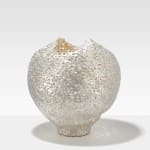




Mimi Joung
Freedom rings like a bell, too loud for ears accustomed to silence, 2024
Porcelain, Silver lustre
48 x 48 x 48 cm
18 7/8 x 18 7/8 x 18 7/8 in
18 7/8 x 18 7/8 x 18 7/8 in
Series: Shadows of yes and no
CF1350
Photo: Mimi Joung
Further images
In her new body of work Shadows of Yes and No, Mimi Joung repeats the same words Yes and No to create various wall and freestanding works in varying shades...
In her new body of work Shadows of Yes and No, Mimi Joung repeats the same words Yes and No to create various wall and freestanding works in varying shades of grey. The work builds on her interest in Dansaekhwa, the Korean monochrome movement, which reconciles the influence of western modernism on Korean artistic culture.
The movement highlighted the post-war struggle within Korea over national identity, belonging and tradition. By using repetitive patterns and gestures, each artist attempted to create an aesthetic style that was universal and belonged to no one.
Her pieces, which she develops and names based on her feelings towards human relationships and emotions, use the repeated form of yes and no to generate sculptural works that ask us to think about the shortest and hardest but perhaps most powerful words in our language.
As you look at her work, she asks you to not simply enjoy the form but also to reflect on your own emotional response. What makes us feel ready to say yes and what drives us to say no? Is life black and white or a more subtle reflection on transience and beauty?
The movement highlighted the post-war struggle within Korea over national identity, belonging and tradition. By using repetitive patterns and gestures, each artist attempted to create an aesthetic style that was universal and belonged to no one.
Her pieces, which she develops and names based on her feelings towards human relationships and emotions, use the repeated form of yes and no to generate sculptural works that ask us to think about the shortest and hardest but perhaps most powerful words in our language.
As you look at her work, she asks you to not simply enjoy the form but also to reflect on your own emotional response. What makes us feel ready to say yes and what drives us to say no? Is life black and white or a more subtle reflection on transience and beauty?
Exhibitions
Selected ExhibitionsLondon Art Fair 2025




